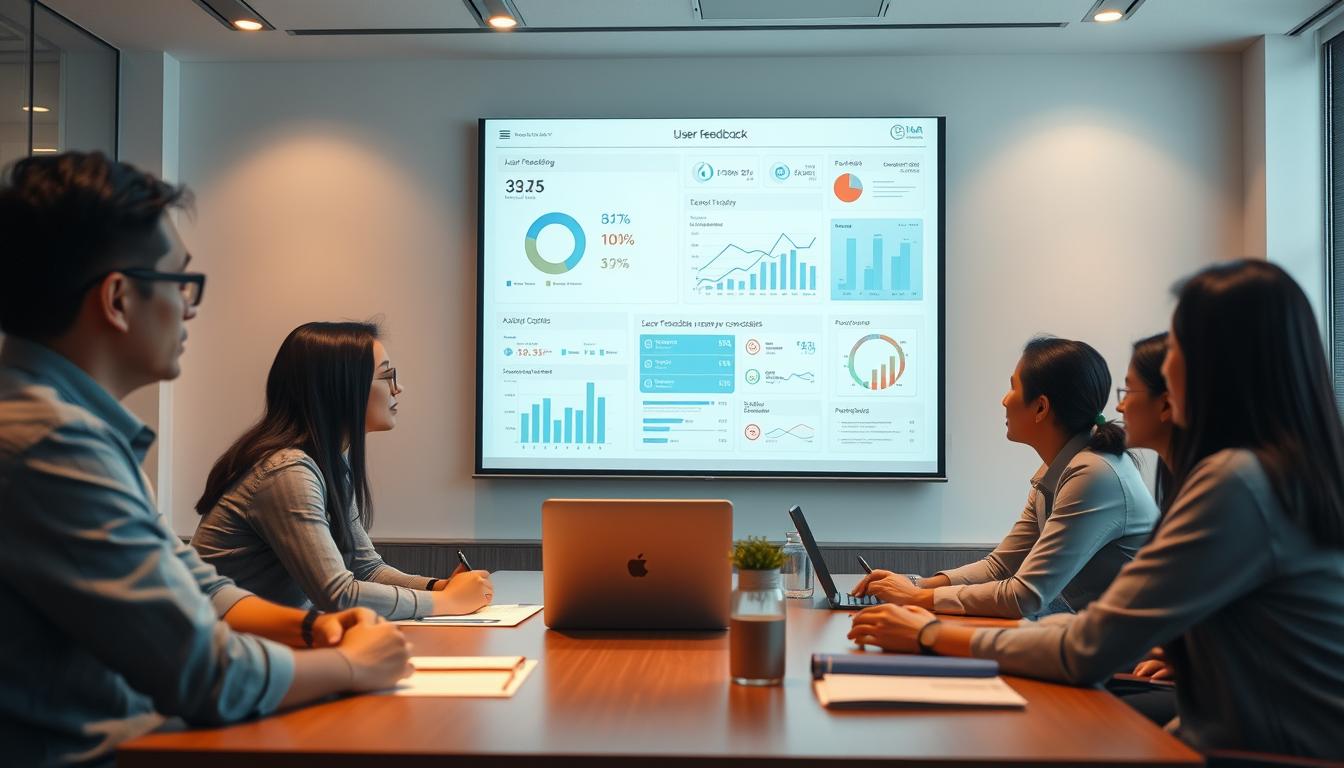Are traditional methods of managing your ERP system holding back your organization’s success? In today’s fast-paced business environment, ERP System Optimization is not just about the technology. It’s about how you interact with your end-users. Regular feedback loops are key for organizations, like small and medium-sized enterprises (SMEs) in the Philippines, to keep improving.
By using a systematic way to collect feedback, businesses can make their operations smoother. They can also make users happier. This article explores how these feedback mechanisms are crucial for improving ERP functionality and performance.
Key Takeaways
- Incorporating regular feedback loops is vital for successful ERP System Optimization.
- Continuous improvement fosters greater user satisfaction and engagement.
- Active participation from end-users allows businesses to identify critical system enhancements.
- Efficient feedback collection can streamline operations and align processes with strategic goals.
- Understanding user needs leads to more responsive ERP systems.
Understanding ERP System Optimization
Companies always look for ways to work better and use their resources wisely. This is why ERP optimization is key. It’s about making the ERP system better to help businesses run smoothly. It makes sure the system fits with the company’s goals and makes it easier for users.
Defining ERP Optimization
ERP optimization means making the ERP system better by streamlining tasks. Companies use new technologies and strategies to make the system stronger. This leads to smoother operations and better business processes.
The Importance of Continuous Improvement
Keeping an ERP system up-to-date is crucial in today’s fast-changing business world. Companies need to update their systems with new technologies and methods. This way, their ERP solutions stay efficient, meet user needs, and help the business run well.
The Role of Feedback Loops in ERP Systems
Feedback loops are key to making ERP systems better. They help organizations find ways to improve and solve problems. By listening to users, companies can make their systems more efficient and user-friendly.
What Are Feedback Loops?
Feedback loops are ways to get user opinions on ERP systems. They use surveys, interviews, and focus groups to collect feedback. This helps companies make better decisions and improve their systems.
How Feedback Loops Enhance ERP Performance
Feedback loops make ERP systems work better. They help find and fix problems. This leads to systems that are easier to use and more effective.
| Feedback Mechanism | Benefit |
|---|---|
| Surveys | Quick insights on user satisfaction |
| Interviews | In-depth understanding of user challenges |
| Focus Groups | Collect diverse perspectives and ideas |
For more on how feedback loops improve team performance, check out this resource. Listening to users helps companies make their ERP systems better and more user-friendly.
Benefits of Regular Feedback Collection
Regular feedback collection is key to boosting user satisfaction and making ERP systems better. It helps create a culture where feedback is valued. This leads to more user engagement and continuous improvement in the ERP system.
Improved User Satisfaction and Engagement
Regular feedback collection makes users happier. When they feel heard, they use the system more. This leads to better work habits, higher productivity, and a more lively work environment.
Happy users become the system’s biggest supporters. They help spread the word and make the system even better.
Identification of Critical System Enhancements
Systematic feedback collection helps find key areas for improvement. By fixing the issues users point out, companies can make workflows smoother. This ensures the ERP system stays aligned with the company’s goals and meets user needs better.
Strategies for Effective Feedback Gathering
Getting valuable feedback from users is key to improving an ERP system. There are many ways to get better feedback. Using the right methods helps get more detailed and useful information for making smart choices.
Surveys and Questionnaires
Surveys and questionnaires are basic tools for getting feedback. They help collect answers in a structured way, focusing on what users think and suggest. They’re easy to use, so more people can share their opinions.
Good questions can reveal a lot about what users like and what needs work.
Focus Groups and Interviews
Focus groups and interviews let users share more about their experiences. They talk about their problems and what they hope for in the ERP system. A leader helps keep the conversation on track, covering all important points.
This way of getting feedback often gives deeper insights than just asking questions. It helps understand users’ needs better.
Incorporating User Analytics
User analytics is important for seeing how people use the ERP system. It shows which parts are not used much and where things slow down. This info helps improve the system based on real data.
Using analytics with other feedback methods gives a fuller picture of how users behave.
| Feedback Method | Description | Benefits |
|---|---|---|
| Surveys | Structured questionnaires distributed to users. | Systematic data collection, higher response rates. |
| Focus Groups | Group discussions led by a facilitator. | Rich qualitative insights, deeper understanding. |
| User Analytics | Data analysis on user interactions with the system. | Identifies usage patterns, enhances targeted improvements. |
Post-Implementation Support and Its Impact
Effective post-implementation support is key to an ERP system’s success. Investing in training programs helps users master the system’s features. This boosts individual productivity and overall efficiency.
In the fast-changing business world of the Philippines, using ERP systems is crucial. It helps businesses stay ahead of the competition.
Training and User Support Programs
Good training programs bring many benefits. They make sure employees know how to use the ERP system well. This leads to happier and more confident users.
Continuous support helps solve problems that come up during work. It’s important for users to feel at ease with the system. This cuts down on mistakes and boosts the system’s value.
The Role of Change Management in ERP
Change management strategies are vital for smooth transitions. They handle user concerns and encourage teamwork. This helps overcome resistance to change.
It makes users feel invested in the system. This leads to smoother updates and changes. With the right support and change management, businesses can get the most out of their ERP systems.
Analyzing User Feedback for ERP Improvements
User feedback is key to making ERP systems better. By understanding what users struggle with, companies can make smart changes. This way, they can fix big problems and make the system work better for everyone.
Identifying Patterns and Common Issues
Spotting patterns in feedback is very important. Companies can find out what’s causing trouble by sorting through user comments. This helps them tackle big problems, not just small complaints.
Prioritizing Feedback Based on Business Goals
It’s important to focus on feedback that helps meet business goals. By sorting feedback by importance, companies can use their resources wisely. This approach leads to real improvements that make users happier and more productive.
Implementing Changes Based on Feedback
After getting and looking at user feedback, companies can start making important changes. They need to plan well for these changes. This ensures they meet technical needs and user wants. A good plan leads to better performance and happier users.
Planning for System Modifications
Good planning is key for system changes. Teams should use user feedback to decide what to change first. Developers, managers, and others work together to make a plan. This plan shows when and how changes will happen, making things smoother.
User Involvement in Change Processes
Getting users involved in changes makes it more likely to succeed. By starting early, users feel they own the changes. They know their needs are being met. Keeping them updated makes them feel part of the team.
| Change Process Stage | User Involvement Actions | Expected Outcomes |
|---|---|---|
| Feedback Collection | Surveys, Focus Groups | Understand user needs |
| Planning Modifications | Workshops, Meetings | Collaborative adaptation |
| Implementation | Training Sessions | Enhanced user skills |
| Review and Improve | Follow-up Surveys | Continuous enhancement |
Monitoring Results After Implementing Changes
After making changes in an ERP system, it’s key to watch the results closely. Setting clear Key Performance Indicators (KPIs) helps see if these changes work well. This way, we can see how changes affect us and keep getting better.
Setting Key Performance Indicators (KPIs)
It’s important to set specific KPIs to measure change success. KPIs can cover things like how users interact, system speed, and how fast things get done. With clear metrics, businesses can see how they’re doing and what needs work.
- System uptime percentage
- User adoption rates
- Transaction speeds
- Error rates in processing
Continuous Feedback Collection Post-Change
Getting feedback regularly is crucial to understand user feelings after changes. Talking to users through surveys or chats helps us see what they think. This ongoing talk helps us make quick fixes to make the ERP system better.
Real-Life Examples from Philippine SMEs
Case studies from Philippine SMEs show how feedback loops improve ERP systems. These examples show how user feedback leads to big improvements in different industries.
Case Study: Retail Company Enhancements
A retail company in the Philippines boosted its order processing by listening to user feedback. They used surveys to find out what was not working well in their ERP system. This led to faster order fulfillment, cutting down time by 30%.
The changes made to meet user needs made both employees and customers happier.
Case Study: Manufacturing Process Optimization
A manufacturing company worked to make its supply chain better, using feedback from regular checks. Users said they had trouble seeing what was happening at each stage of production. So, the company added new tools to its ERP system to help with this.
This change cut down on costs, showing how important it is to make ERP systems better based on what users say.
Conclusion
Regularly using feedback loops is key for a well-optimized ERP system. These loops help companies grow and change with the market. They also make sure the system meets user needs.
By listening to users, businesses can improve continuously. This not only makes the system better but also keeps users happy.
For small and medium-sized enterprises (SMEs) in the Philippines, using feedback loops is very important. It helps them deal with new technology and stay ahead in the market. By focusing on user feedback and always improving, companies can succeed in a fast-changing world.
FAQ
How do feedback loops contribute to ERP optimization?
Feedback loops help organizations get insights from users about the system’s performance. This structured way allows for ongoing improvements. It ensures the ERP system meets user needs, boosting efficiency and functionality.
Why is continuous improvement essential for ERP systems?
Continuous improvement keeps ERP systems up-to-date with changing business needs. By using new technologies and methods, organizations can improve performance. This leads to better user adoption and overall efficiency.
What strategies can organizations use to gather effective feedback?
Organizations can use detailed surveys, focus groups, and user analytics to gather feedback. These methods offer valuable insights into user experiences. They help identify areas for improvement in the ERP system.
What impact does post-implementation support have on ERP success?
Post-implementation support, including training and change management, is key. It ensures users can use the ERP system efficiently. This support helps overcome resistance and promotes collaboration, making system updates smoother.
How do organizations analyze user feedback?
Organizations analyze feedback by looking for patterns and common issues. This helps them focus on solving systemic problems, not just isolated complaints. It ensures enhancements meet user needs effectively.
Why is user involvement important in planning system modifications?
User involvement in planning makes users feel invested in the changes. It ensures modifications meet their real needs. This boosts user engagement and retention, making successful implementation more likely.
What are Key Performance Indicators (KPIs) in ERP monitoring?
KPIs are metrics used to check if ERP system changes are working. By monitoring KPIs, organizations can see if changes are effective. This supports ongoing adjustments to keep the system performing well.
Can you provide examples of successful ERP feedback implementation?
Yes! A retail company in the Philippines improved order processing thanks to user feedback. It streamlined interfaces. A manufacturing firm also optimized its supply chain management through feedback. This led to better visibility and lower costs.



